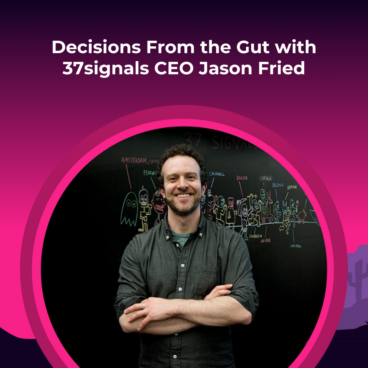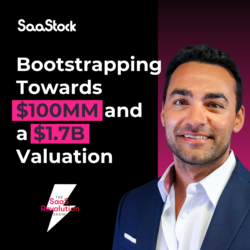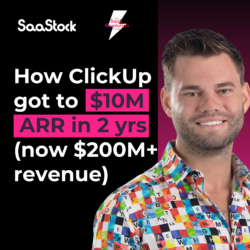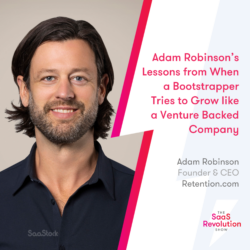Sometimes, in the run up to an event, you confirm parts of it that you just know are going to be special. Whether seeing a new concept come to life, working with different partners, or adding to the agenda, these moments build the excitement for me because I know we’re adding more value for those who attend.
That’s what happened when we booked 37signals CEO Jason Fried to speak at SaaStock USA. It was nine years in the making, so a conversation I was looking forward to but also one I knew would bring a valuable, different perspective for our attendees.
A founder of 24 years, Jason is known for contrarian views on how to build a business. In the chat, we covered decision making, goal setting, bootstrapping to financial freedom, and more. You can watch the whole thing below or read on for my key takeaways.
On goal setting
“Goals are made up numbers that you aim for and then you either hit them or you don’t. That’s just not that interesting to me.”
Not many founders stay in the same business, with the same co-founder, for more than twenty years. But Jason has. When asked, he put this down to the fact that he thinks year to year, rather and long term.
And this is a theme that bled into how he thinks about goals setting – or rather, not goal setting.
At 37 Signals, there is just one, simple goal – to be profitable. He said:
“As long as we make more than we spend, we’re good. Everything else, it doesn’t matter to me. And I don’t care if we make more profit this year than last year. I just want to make more than we spend, and I’m happy with that.”
As a founder myself, we set annual, quarterly, and even longer term goals but his reasoning behind not doing this was interesting – and based on personal experience with running rather than a business lesson.
He’d been trying to run a six minute mile, and was disappointed with himself if he didn’t hit. But soon realised, he was looking at it the wrong way:
“I was asking myself the wrong questions…It should have been, did I enjoy it, did I get good exercise, did I get fresh air, and do I want to do it again. Those are the questions to ask and it’s not about a goal, it’s about a general feeling.”
Outside of remaining profitable, he brought this mentality into the business and instead focuses on doing the best work they can and “letting the chips fall where they may”.
Without goals, I wanted to know how he sets the business direction. Internally, it’s through ideas about what they want to build or improve. And again, the measure of it is based on that gut feeling and qualitative feedback. Whether they’re proud of it, whether they feel good about what they’re doing, and whether they’re hearing good things from their customers.
On bootstrapping
“The bootstrappers who work now to try and figure out how to make money are practising the skill that they’re going to need forever.”
Jason has bootstrapped his way to financial freedom, something every entrepreneur aspires to but for most it’s at exit. So for me, the question was simple, how do you do it?
Unsurprisingly, it starts with keeping costs as low as possible. Something that sounds obvious but, in Jason’s view, isn’t how a lot of founders think.
“You should be incredibly frugal when you’re getting going. The smallest possible team, don’t waste money on over-branding things…Keep it cheap, simple.”
He also advises doing as much yourself as you can because once you start outsourcing to contractors or consultants, the bills “just go flying”.
Ultimately, you need to get good at learning how to make money and doing these things from the start helps you settle into that mindset.
“If you have an abundance of something early on, you don’t have to get good at that. So, a lot of entrepreneurs who raised money early, never got good at making money. And then, right now when money isn’t available, they’re screwed. The bootstrappers who work their asses off and try to figure out how to make money now are practising the skill that they’re going to need forever.”
As well as getting good at making money, he advocates for pulling money out of the business along the way, rather than always reinvesting back in. He said:
“Pull out money along the way so you have something to show for your work because there’s a very good chance it isn’t going to work.”
On customer acquisition
“It’s not a quantity game. The way you cut through is by saying something interesting from a unique point of view.”
As a company, 37signals develops products that they want first but it’s built on the knowledge that there are a lot of people and companies just like them that want the same thing.
Over time, 37signals and its project management tool Basecamp has garnered a big, loyal following of small business owners, entrepreneurs, and design firms.
“What’s great about an audience is that they’re there for you and they’re waiting for you to tell them something. So, we know what we’re building stuff for small businesses, we are a small business, we know what small businesses need – and it’s not watered down versions of bigger products.”
To grow the audience, Jason and business partner David Heinemeier Hansson, share a lot with them – both on social media, on their blog, and in their books. They also ask them for input on new products, email platform Hey and chat solution Campfire. It’s a go-to-market (GTM) strategy that’s led to powerful organic growth.
“We get [the word] out on Twitter, LinkedIn, the word spreads, and we grow organically that way. We don’t buy any ads. We’ve experimented with that here and there but mostly it’s organic growth and word of mouth.”
With a GTM built on content marketing (though he doesn’t like the term), Jason gave us his tips for cutting through the noise in a saturated market.
“It’s not a quantity game. The way you cut through is by saying something interesting. By saying something from a unique point of view. Being consistent or changing your mind but being open about that.”
The overarching message here was “write when you have something to say”. For Jason, it means regular posting on X/Twitter and roughly weekly posting elsewhere – though this isn’t tied to an editorial schedule.
Get more from SaaStock USA
Nine years in the making, this conversation didn’t disappoint. At a difficult time for many, it was great to hear Jason’s fresh perspective on things we often get stuck in the weeds with. We covered a lot more ground than I’ve mentioned here, so really recommend checking out the full session if you get a chance.
We’re also adding other sessions from the likes of April Dunford (Ambient Strategy), Steve Rowland (Klaviyo), and Ashley Grech (Xero) over on our YouTube – subscribe to stay up to date.
This post was first published in our SaaStock Blueprint newsletter. Subscribe now to get insights like this, straight to your inbox.





